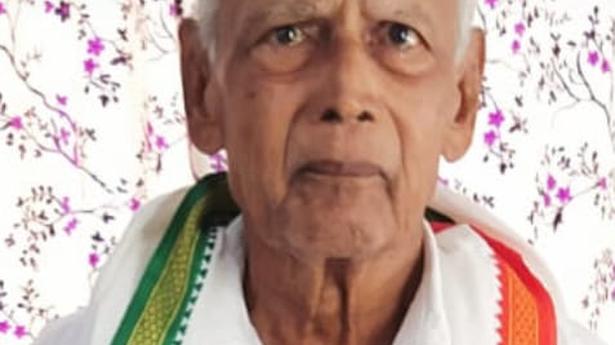
Tribute to Mudakkal Gopinathan Nair, who defined Kathakali music of southern Kerala
The Hindu
Mudakkal Gopinathan Nair will be remembered for his clear enunciation of words and notes
The only time his master punished Mudakkal Gopinathan Nair was when they were on stage. Eighteen consecutive nights of Kathakali had tired both musicians, leading the pupil to doze off at another show. “A slap on the forearm brought me to senses. I saw my teacher with the gong stick,” Mudakkal Gopinathan Nair would recall half-a-century later, saluting Thakazhi Kuttan Pillai, who taught him vocals for the dance-theatre.
Nair passed away on August 6, months short of turning 90. That was the age at which Thakazhi Kuttan Pillai (1918-2007) died too. Busy in their heyday, the duo effectively defined Kathakali music of southern Kerala along the second half of the 20th century. Into the 1970s, though, their artistic journey needed to weather certain ‘encroachments’ by talented youngsters of upstate Kalluvazhi idiom.
Contrasting the Carnatic slant propagated by Neelakantan Nambisan and his frontline disciples from Kalamandalam near Shoranur, Kathakali’s Kapligandan style that groomed Mudakkal Gopinathan Nair remained rooted in the ethnic Sopanam music. Allied to temples, this bhakti-centric stream rarely sounded ornamental, making the derivate Kathakali music plain.
Like his tutor Gopinathan Nair’s vocals featured a trademark loop. Observes actor Margi Vijayakumar: “You simply couldn’t differentiate between the two artistes.” That distinct gamaka stayed with Nair despite the occasional guidance from Nambisan (1920-85), and a still briefer tutelage under Cherthala Kuttappa Kurup. The lone compromise that he made was to allow the juniors playing the cymbals stand to his left (as is the northern custom).
Gopinathan showed earnestness to sing for plays that were new or being revived. “His guru would instruct Gopinathan to memorise the lyrics, and he’d be ready within two weeks,” recalls octogenarian dancer Kalamandalam Gopi, referring to works such as Nishada Arjuneeyam and Pratijna Kautilyam that had gone off the dais.
Such clarity was due to his training in Carnatic music when he was young. From age 11, Gopinathan learned classical from Kilimanoor Ramachandran . Subsequently he studied under Kuttan Pillai by staying at his house near Mudakkal. At 16, Gopinathan Nair debuted in his native place, assisting Pillai in anchoring ‘Santanagopalam’ at Edayavanathu Devi shrine.
The road ahead was tough. “There used to be just two vocalists for the entire night. The pay was dismal,” Gopinathan Nair used to reminisce. Barring a decade’s association with Satsangam Centre in the state capital, he thrived as a freelancer, singing for maestros as well as novices over generations. A handful of awards did come, they rarely matched his eminence. “The last flag-bearer of pristine Kathakali music,” opines septuagenarian vocalist Kalanilayam Unnikrishnan.











